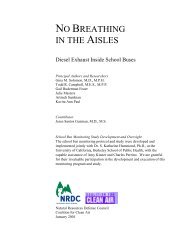US Nuclear Weapons in Europe - Natural Resources Defense Council
US Nuclear Weapons in Europe - Natural Resources Defense Council
US Nuclear Weapons in Europe - Natural Resources Defense Council
You also want an ePaper? Increase the reach of your titles
YUMPU automatically turns print PDFs into web optimized ePapers that Google loves.
U.S. <strong>Nuclear</strong> <strong>Weapons</strong> <strong>in</strong> <strong>Europe</strong> • Hans M. Kristensen/<strong>Natural</strong> <strong>Resources</strong> <strong>Defense</strong> <strong>Council</strong>, 2005<br />
NEW PRESIDENTIAL GUIDANCE BUT NO CHANGE<br />
While the political circumstances and the number of nuclear weapons <strong>in</strong> <strong>Europe</strong> changed<br />
dramatically between 1990 and 1997, the U.S. presidential guidance for how the military<br />
should plan for the potential use of the weapons did not. In mid-1997, White House<br />
guidance for how the military should plan nuclear war was still based on the guidance<br />
issued by President Reagan <strong>in</strong> 1981. F<strong>in</strong>ally, <strong>in</strong> October 1997, President Cl<strong>in</strong>ton signed<br />
Presidential Decision Directive 60 (PDD-60) order<strong>in</strong>g the military to no longer plan for<br />
fight<strong>in</strong>g a protracted nuclear war with the Soviet Union.<br />
The half a decade that passed between the demise of the Soviet Union and this document<br />
should have enabled the president to safely order the removal of nuclear weapons from<br />
<strong>Europe</strong>. But the focus of PDD-60 was about reduc<strong>in</strong>g strategic forces <strong>in</strong> preparation for a<br />
START III agreement, and the non-strategic nuclear weapons commitment to NATO was<br />
not changed.<br />
Shortly after PDD-60 was issued, amidst a debate over whether NATO would deploy<br />
nuclear weapons to the new member states, the U.S. Under Secretary of <strong>Defense</strong> for<br />
Policy Walter Slocombe published an article <strong>in</strong> NATO Review, where he expla<strong>in</strong>ed that<br />
the “current nuclear posture is adequate for an enlarged alliance….” 161<br />
Part of that posture was tested <strong>in</strong> late 1998, when F-15Es from the 4 th Fighter W<strong>in</strong>g at<br />
Seymour Johnson Air Force Base <strong>in</strong> North Carol<strong>in</strong>a simulated a nuclear strike <strong>in</strong> support<br />
of NATO. The simulated strike occurred as part of STRATCOM’s Global Guardian 99<br />
exercise held from October 24 to November 2, 1998. STRATCOM <strong>in</strong>itially showed little<br />
<strong>in</strong>terest <strong>in</strong> <strong>in</strong>corporat<strong>in</strong>g fighter-bomber nuclear operations <strong>in</strong>to Global Guardian 99, and<br />
this was only the second year that the 4 th Fighter W<strong>in</strong>g participated <strong>in</strong> the global nuclear<br />
exercise. The employment phase of the W<strong>in</strong>g’s operations <strong>in</strong>cluded dropp<strong>in</strong>g 10 BDU-<br />
38s (B61 shapes filled with concrete) on a bomb<strong>in</strong>g range (presumably Florida). 162<br />
Incorporat<strong>in</strong>g dual capable aircraft <strong>in</strong>to a STRATCOM exercise was a new phenomenon<br />
reflect<strong>in</strong>g the command’s <strong>in</strong>creas<strong>in</strong>g role <strong>in</strong> regional nuclear target<strong>in</strong>g and a soften<strong>in</strong>g of<br />
the separation of strategic and non-strategic nuclear forces. Today, STRATCOM is<br />
tasked by the Jo<strong>in</strong>t Staff to produce, at the theater CINC’s request, a series of plann<strong>in</strong>g<br />
documents for the plann<strong>in</strong>g and execution (probability of strike success, probability of<br />
weapon arrival, fatalities, casualties, dispersion patter of radioactive debris, etc.) of<br />
various nuclear strikes with ballistic missiles, cruise missiles, and gravity bombs. As of<br />
mid-1997, this plann<strong>in</strong>g was completed, except for DCA and gravity bombs. 163 One<br />
objective of the 1998 exercise was to verify the route plann<strong>in</strong>g for the 4 th Fighter W<strong>in</strong>g<br />
aircraft to their <strong>in</strong>tended targets.<br />
Call for Review of NATO Policy Opens Debate<br />
The 1999 Wash<strong>in</strong>gton Summit provided an opportunity for NATO to reshape its mission<br />
for the twenty-first century. A review of the nuclear policy and posture was part of this<br />
process. Yet the road to the new Strategic Concept was far from a smooth ride. In<br />
November 1998, Canada and Germany staged what looked like a nuclear revolt by<br />
53
















